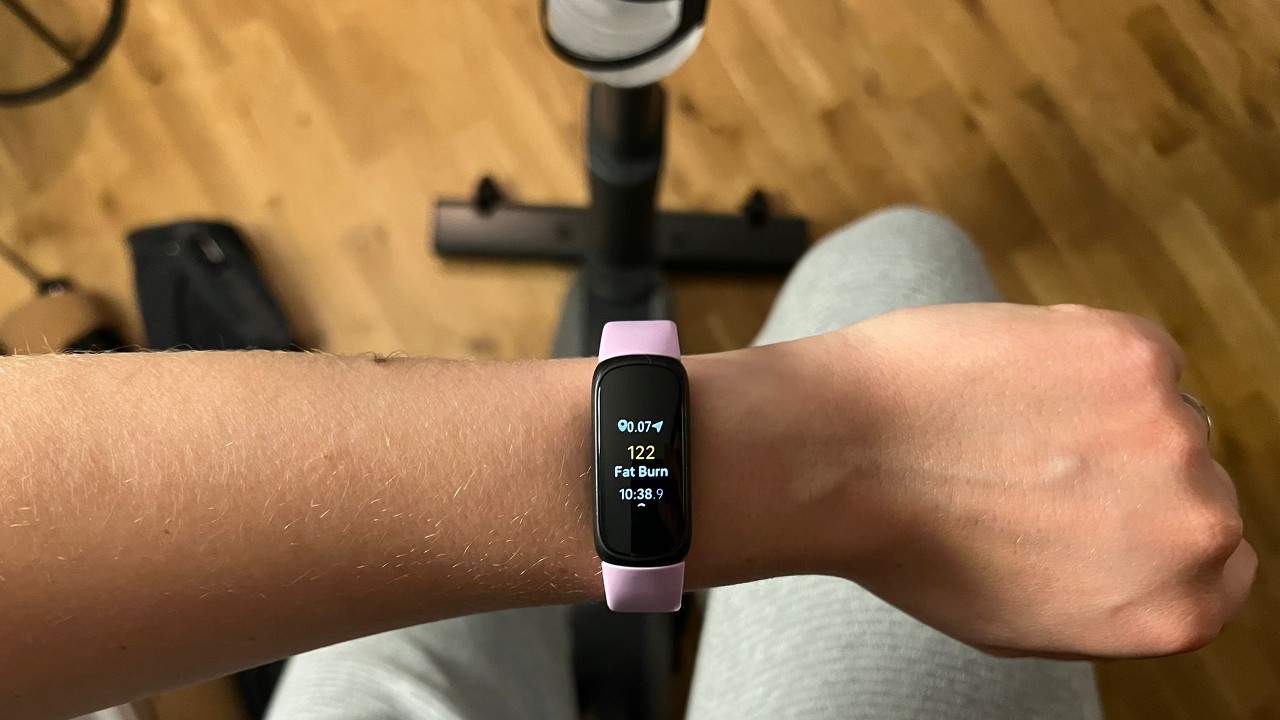Our Verdict
The Fitbit Inspire 3 offers detailed health tracking at a decent price, but its small screen, lack of built-in GPS and inability to deal with water let it down.
For
- Comprehensive tracking
- Easy to use
- Six-month Fitbit Premium subscription
Against
- Small screen
- Short charging wire
- No built-in GPS
You can trust Coach
It’s easy to think that because you’ve tried one Fitbit, you’ve tried them all – and to some extent, that’s true. There are very few surprises with the Fitbit Inspire 3, but on the plus side, you do know exactly what you’re getting: a well-designed, lightweight tracker that logs your activity, along with a detailed companion app showing you lots (and lots) of data.
Improvements over previous Inspire models include a colour display with an always-on feature and SpO2 tracking, which measures your blood oxygen saturation.
I tested the Inspire 3 for more than a month to see how it fared against the best cheap fitness trackers, wearing it most of the time to track my daily activity, exercise, health metrics and sleep.
Fitbit Inspire 3: Price And Availability
First announced on 24th August 2022, Fitbit’s Inspire 3 is available now and costs £84.99 in the UK or $99.95 in the US. You get a six-month Fitbit Premium membership included when you buy the tracker, which must be activated within six months of the purchase. You can cancel this before the free access period is over or continue with the subscription at £7.99/$9.99 a month or £79.99/$79.99 a year.
The Set-Up
The Inspire 3 comes in a neatly packaged box with a quick-start guide to get you up and running. You need to download the Fitbit app to start using the device and will be prompted to charge the Fitbit fully when you first switch it on, which took an hour and a half. Once that’s done, the tracker syncs automatically with the app.
Overall, set-up was very straightforward and I didn’t have any issues. It is, however, worth taking some time to go through all the available features – several need to be manually switched on before they’ll start tracking data.
Design
I tested the Black Case with the Lilac Bliss band, but you can also buy Midnight Zen (black) or Morning Glow (orange) bands. Both small and large straps are included.
The colour touchscreen has an always-on display option and a variety of clock faces. It is on the smaller side, which meant I didn’t really use it to check call, text or app notifications, and on some screen layouts the text was cut off or awkwardly displayed.
The band itself is secure and never came loose during testing. It looked like new after more than a month of wear. You can also purchase different straps or a clip to attach the device to your clothing if you prefer a pedometer.
The central display, though slim when viewed from the front, is quite chunky from the side. I have small wrists, and despite using the smallest band that was included, the fit was gappy around the sides of the display – there was no way to get it to sit flush against my wrist. This meant that the watch felt clunky and I was certainly aware that I was wearing it at all times.

Battery Life
The battery on the Inspire 3 can last up to 10 days, although I found it lasted for three days with the display set to always-on and tracking one workout a day. To combat this, you can turn off the always-on display, which eats up the battery life. Helpfully, Fitbit sends an email whenever the watch needs recharging.
App And Health Tracking
As expected with Fitbit, the sheer amount of data you can access is impressive. An at-a-glance overview on the app shows steps, distance, calories burned, Active Zone Minutes (time spent with an elevated heart rate), sleep score, resting heart rate, menstrual tracking and more. You can also log food and water intake, and weight.
Some metrics are available only to Fitbit Premium members. A six-month Fitbit premium membership is included when you purchase the band, so it’s worth taking a deep dive into the features while you have free access, then deciding if it’s worth the additional cost.
Premium also includes a daily readiness score (an indicator of how prepared your body is for physical activity), advanced sleep analytics, video workouts and recipe inspiration – as well as extra mindfulness sessions.

The band monitors your heart rate, showing your current bpm and resting heart rate on the app home screen. You can also check previous data, view your resting heart rate over the past 30 days, see an estimation of your cardio fitness score and how it compares with that of others your age, and see how many minutes you’ve spent in three different heart rate zones: fat burn, cardio and peak.
The band also notifies you if it spots a high or low heart rate (using pre-set thresholds, which you can customise) or if it notices an irregular rhythm, which can be a sign of atrial fibrillation. If you do get one of these notifications, the app prompts you to make an appointment with your doctor and provides irregular rhythm readings to share with your physician.
The Inspire 3 also includes an SpO2 sensor, which can be viewed by swiping up from the clock face on the band or within the Health Metrics section of the app. There’s also the ability to connect a separate blood glucose meter or app.
Menstrual cycle tracking is also available on the app, although you will have to manually log your data for this, inputting patterns, symptoms and ovulation test results. The more data you enter, the better the algorithm becomes at predicting your period and fertility patterns, and you can opt to turn on push notifications for this.
Exercise Tracking

There are 20 activities available to track, including walking, running, cycling, swimming, yoga, tennis, circuit training, weight lifting and golf. You can set up six shortcuts on the watch to tap into these tracking modes. The watch allows you to simply start a session or set a particular goal, such as Zone Minutes, distance, time or calories for your workout.
There’s no built-in GPS tracking on the Inspire 3, but it can use connected GPS to map your route during outdoor exercise (you’ll need to bring your phone with you in order for this to work).
During workouts, you can see real-time stats including steps, distance, laps and heart rate. I tested the band during walks, indoor bike rides, swims, yoga sessions and strength training, and generally found it to be accurate. The steps and heart rate matched data recorded by other trackers and the workout logs synced automatically with the app.
Keen swimmers, take note – the screen doesn’t respond well when wet. This is something that Fitbit is clearly aware of, since it has designed a “water lock” mode that’s accessible when you swipe up from the clock face. This is activated via two firm taps, which takes quite a long time to master. There’s no automatic stroke recognition, with tracking limited to duration, distance (you need to set the pool length) and pace.
Sleep Tracking
Fitbit calculates your overall sleep score using duration, quality and restoration, giving you a figure out of 100. You can also delve further into the different sections in the app, including graphs showing your time asleep and awake, sleep stages such as Deep, Light and REM sleep, your sleeping heart rate, restlessness and estimated oxygen variation (designed to spot breathing issues).
The watch includes a Sleep Mode to block notifications and stop the screen from lighting up each time you turn over and this works very well. You can also use Smart Wake to wake you up during a light sleep stage within the 30 minutes leading up to your set alarm time. This is meant to help you ensure you’re waking up at the best possible time, but when I tried it, I just snoozed the alarm and fell asleep again (not sure I can blame that on Fitbit, though).
Is The Inspire 3 Worth It?

I enjoyed using Fitbit’s Inspire 3. It allowed me to take stock of my current habits and implement healthier ones, such as taking more steps each day, getting up and stretching at regular intervals and going to bed (slightly) earlier. It also helped me notice and feel good about the days where I exceeded my step goal, slept better than I thought or increased my Active Zone Minutes.
The Fitbit app is well designed and easy to navigate, with plenty of explanations and tips to help you make the most of the statistics. The sleep tracking, heart monitor and SpO2 sensor are all accurate and consistent. However, the sheer volume of data on Fitbit Premium is quite overwhelming and most people purchasing at this price point will be happy with the basic data provided by the band itself, which is still very comprehensive.
I preferred the design of the cheaper Huawei Band 7. It has a larger, more responsive display and a more snug fit against my wrist. Huawei also caters to a wider variety of workouts, as well as automatically recognising your stroke during swimming. That said, if you’re a stickler for stats, you’ll be hard pushed to find a more detailed data log than provided by Fitbit.
Elite athletes or serious swimmers will need more specialist sports watches or dedicated swimming watches – the small screen and difficulty dealing with water are likely to be an issue. However, on the whole, the Inspire 3 is a great entry-level fitness tracker at a very reasonable price.

Sarah is an experienced health, fitness, nutrition and beauty writer, and was previously health editor at BBC Good Food. She has contributed reviews, interviews and features to Coach since 2019, covering exercise bikes, fitness trackers and apps, among other topics. In her free time, she can be found hiking, swimming, cycling or trying (and failing) to do a headstand on a yoga mat.

